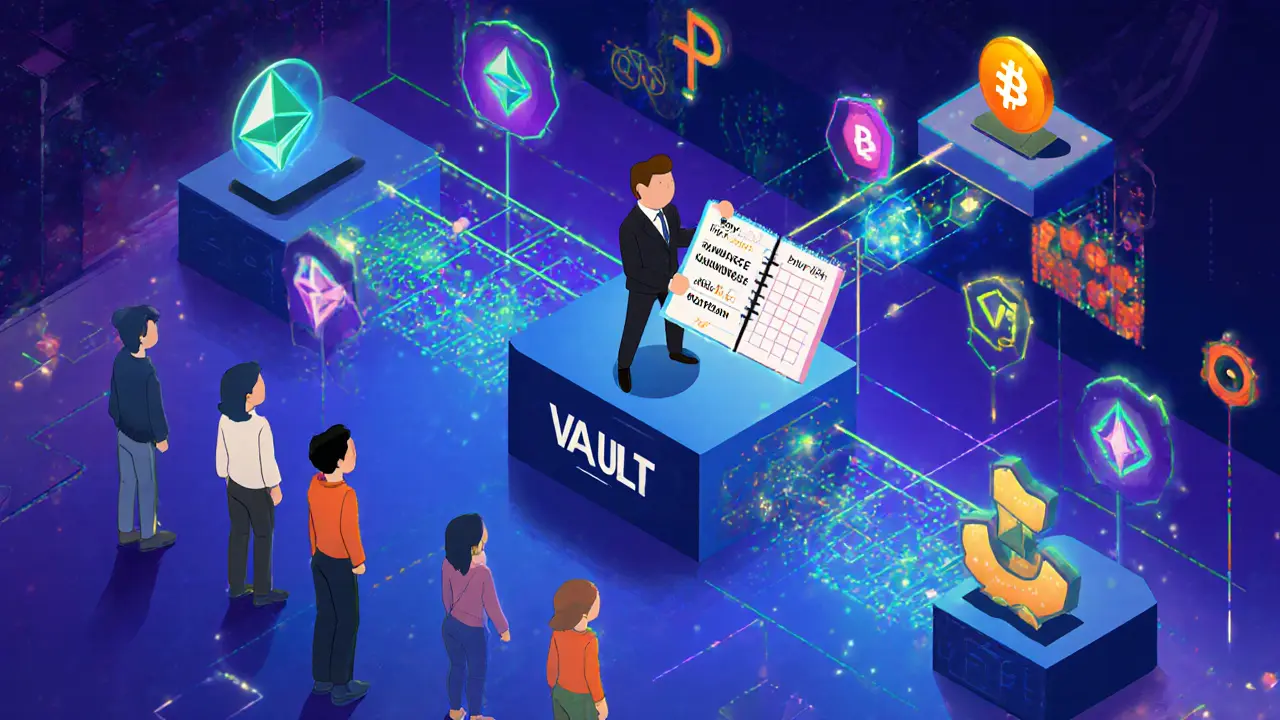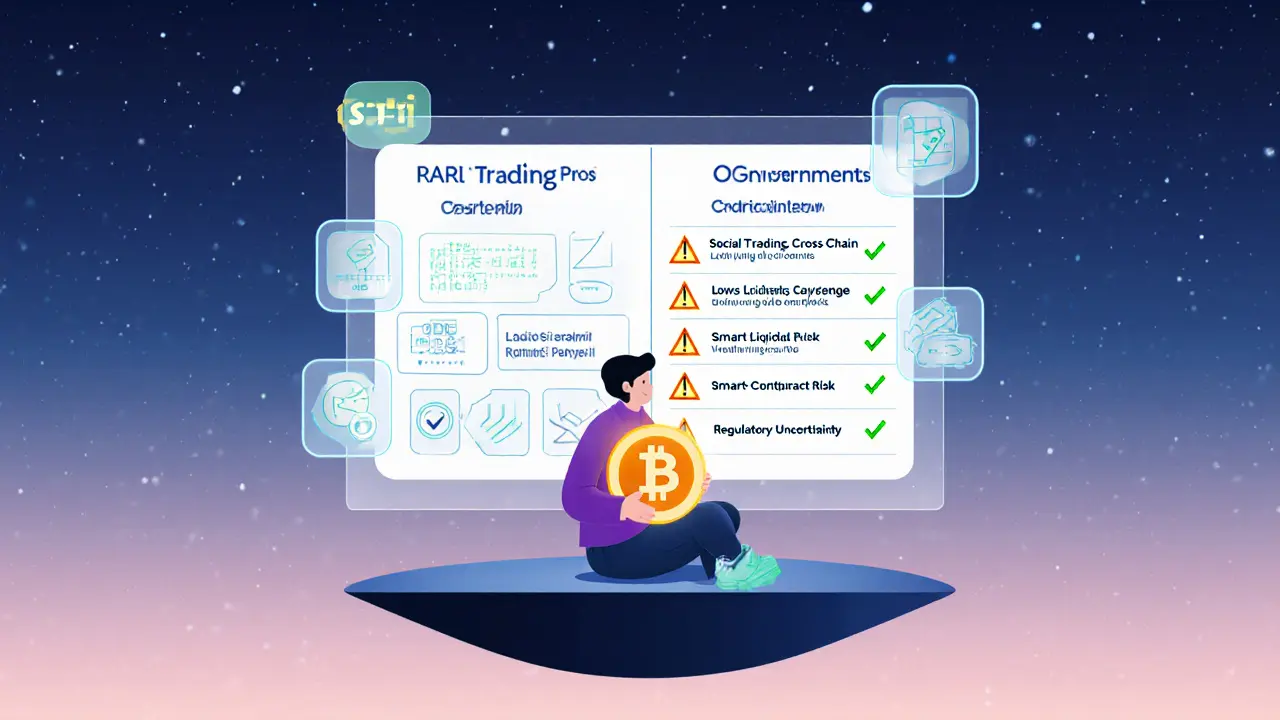RAI Finance SOFI Token Value Calculator
Current Market Data
Estimated Value
RAI Finance is a decentralized finance protocol that blends social trading with cross‑chain swapping. If you’ve ever felt overwhelmed by the need to design your own trading strategy on a regular DEX, this platform promises to let you copy proven traders with a few clicks.
TL;DR - Quick Takeaways
- RAI Finance lets users follow vetted traders via vaults that automatically execute swaps.
- It operates on multiple blockchains, leveraging Polkadot‑based bridges for liquidity aggregation.
- The native governance token, SOFI, trades around $0.000147, giving a rough purchase power of 6,800SOFI per US dollar.
- Liquidity is modest (≈$2M market cap), so large trades may face slippage.
- Best for users who want DeFi exposure without building complex strategies from scratch.
What Exactly Is RAI Finance?
Founded in 2020 in South Korea, RAI Finance set out to solve the fragmentation problem that plagues the DeFi world. Instead of a single‑chain DEX, it aggregates swaps across several networks and layers a social‑trading interface on top. Think of it as a hybrid between a traditional crypto exchange and a copy‑trading platform, but fully on‑chain.
The protocol runs an automated market maker (AMM) that can be tuned for different asset‑pair relationships. This flexibility is meant to boost returns for liquidity providers while keeping risk in check.
How Does Social Trading Work on RAI Finance?
At the heart of the platform are Vaults. A vault contains a pre‑programmed strategy created by a professional trader. For example, a strategy might be: "Buy ETH when the ETH/BTC ratio drops below 0.025, sell when it rises above 0.035." The ratio data is fetched from on‑chain oracles, and the vault’s AMM handles the swap automatically.
Users simply allocate their capital to a vault and watch the performance dashboard. When they decide to exit, the vault redeems their share in USD‑stable value, shielding them from volatile price swings of the underlying assets. This "set‑and‑forget" model reduces the learning curve dramatically compared to building a strategy on Uniswap or SushiSwap from scratch.
Cross‑Chain Compatibility - Why It Matters
Most DEXs live on a single blockchain, meaning liquidity is siloed. RAI Finance connects to the Polkadot ecosystem and other EVM‑compatible chains, pulling together liquidity pools from each. The result is better depth and lower slippage for the same token pair, especially for less‑traded assets.
For traders, this means you can execute a strategy that involves, say, swapping a Binance Smart Chain token for a Polygon‑based stablecoin without hopping between multiple wallets or bridges manually. The protocol handles the routing behind the scenes.
Tokenomics of the SOFI Governance Token
The native token, SOFI, serves three core purposes:
- Governance: Holders vote on fee structures, liquidity‑mining rewards, and which vaults get featured.
- Staking: Staking SOFI can boost a user’s share of protocol revenue, acting as an incentive for long‑term participation.
- Fee Discount: Active participants enjoy reduced transaction fees on swaps and vault entries.
With a circulating supply of about 1.4billion tokens and a market cap near $2M, SOFI is still in the early‑stage pricing zone. Institutional backing from NGC Ventures and early investors like GBIC and Alphabit Fund signal confidence, but the token’s thin order books can lead to noticeable price impact on modest trades.

Pros and Cons - A Balanced Look
- Pros:
- Social trading lowers the barrier for DeFi newcomers.
- Cross‑chain swaps improve liquidity depth.
- Governance gives token holders a voice.
- Vault performance metrics are transparent on‑chain.
- Cons:
- Overall liquidity is limited; large orders may suffer slippage.
- Understanding vault mechanics can still be complex for absolute beginners.
- Documentation is technical; fewer step‑by‑step tutorials compared to big exchanges.
- Regulatory uncertainty around decentralized copy‑trading could affect future compliance.
How RAI Finance Stacks Up Against the Competition
| Feature | RAI Finance | Uniswap (V3) | Binance |
|---|---|---|---|
| Social Trading | Yes - vaults copy professional strategies | No - pure AMM | No - centralized order book |
| Cross‑Chain Swaps | Multi‑chain (Polkadot, EVM) | Ethereum only (with limited layer‑2) | All major chains via centralized bridges |
| Liquidity (USD) | ≈$2M (small) | ≈$30B (large) | ≈$450B (massive) |
| Governance Token | SOFI - holder voting | UNI - holder voting | BNB - utility, not governance |
| Fee Structure | Variable, discounts for stakers | 0.05‑0.3% per swap | 0‑0.1% maker/taker |
| Regulatory Status | Decentralized, higher risk | Decentralized, similar risk | Registered exchange in multiple jurisdictions |
The table shows why RAI Finance is a niche tool rather than a direct competitor to giant centralized platforms. Its unique selling point is the blending of social trading with cross‑chain liquidity.
Getting Started - A Practical Walkthrough
1. Install a Web3 wallet - MetaMask, Binance Web3 Wallet, or any compatible app.
2. Buy SOFI - You can acquire the token on a DEX like SushiSwap or on a centralized exchange such as KuCoin, then transfer it to your wallet.
3. Connect to RAI Finance - Visit the official site, click “Connect Wallet,” and approve the connection.
4. Select a Vault - Browse the strategy list, check performance stats (APR, max drawdown, trader reputation), and allocate the amount you want to lock.
5. Monitor & Exit - The dashboard shows real‑time P&L. When you’re ready, hit “Withdraw” to receive a USD‑stable token (e.g., USDC) back in your wallet.
While the steps are straightforward, remember that each blockchain swap incurs gas fees, and vaults may have minimum lock periods.
Security, Risks, and What to Watch Out For
Because RAI Finance is fully on‑chain, the main security concerns revolve around smart‑contract bugs and oracle manipulation. The protocol has undergone third‑party audits, but no audit can guarantee zero risk.
Key risk factors:
- Smart‑contract exploits: A flaw could expose locked funds.
- Oracle attacks: Manipulated price feeds could trigger unwanted swaps.
- Liquidity scarcity: Low depth may cause high slippage, especially for larger vault positions.
- Regulatory clamp‑down: Copy‑trading in a decentralized environment may attract scrutiny in the future.
Mitigation tips: keep vault allocations small until you trust a trader’s track record, use hardware wallets for storage, and stay updated on audit reports posted in the community channels.
Community Pulse and Future Outlook
Recent surveys indicate about 71% of RAI Finance users are bullish, citing the platform’s innovative approach. However, the modest trading volume and market cap suggest it’s still early days. Upcoming roadmap items include deeper integration with additional parachains, UI improvements for novice users, and a bounty program for independent auditors.
If DeFi continues moving toward multi‑chain interoperability, a protocol that already supports cross‑chain vaults could capture a larger slice of the market. On the flip side, the platform must overcome liquidity constraints and simplify onboarding to reach mainstream traders.
Bottom Line - Is RAI Finance Worth Your Time?
For anyone comfortable with Web3 wallets and looking to dip their toe into algorithmic trading without writing code, RAI Finance offers a compelling middle ground. The combination of vault‑based social trading and cross‑chain swaps is unique among DeFi projects. That said, the thin liquidity and steeper learning curve compared to a centralized exchange mean you should start with modest amounts and test multiple strategies before committing larger funds.
In short, if you’re after a RAI Finance review that balances novelty and risk, think of it as a specialized tool in your DeFi toolbox-not a one‑stop shop for all crypto trading needs.

Frequently Asked Questions
What is the main difference between RAI Finance and a regular DEX?
RAI Finance adds a social‑trading layer (vaults) that lets users copy proven strategies automatically, whereas typical DEXs like Uniswap only provide swap functionality.
How do I acquire the SOFI token?
You can purchase SOFI on secondary markets such as KuCoin or through a DEX swap (e.g., USDT → SOFI on SushiSwap). After buying, transfer the tokens to a Web3 wallet that you’ll connect to the RAI Finance interface.
Is there a minimum amount to join a vault?
Vaults typically set a low entry threshold (often around $10‑$20 worth of assets) to keep the platform accessible, but each strategy may define its own minimum.
Can I withdraw my funds at any time?
Most vaults allow on‑demand withdrawals, converting your share into a stablecoin (e.g., USDC). However, some strategies may impose a short lock‑up period to protect against rapid inflow/outflow.
What are the biggest risks of using RAI Finance?
Key risks include smart‑contract bugs, oracle price manipulation, low liquidity causing slippage, and potential regulatory changes that could affect decentralized copy‑trading.


RAI Finance is a total scam and anyone using it is wasting their time.
omg i totally get u, this whole RAI thing feels like a wild rollercoaster lol
its like they promise social trading but end up dumping code that even i cant follow.
I've been following the rise of decentralized social trading platforms for quite some time now, and RAI Finance certainly adds an interesting twist to the ecosystem.
First, the concept of allowing users to copy successful traders directly on-chain is appealing because it reduces the barrier to entry for newcomers.
However, the execution matters a lot; the platform's UI feels a bit rough around the edges, which can deter users who are not tech‑savvy.
The tokenomics of the SOFI token, with a price near $0.000147, suggest a very low entry point, but that also means high volatility and potential dilution.
The calculator feature in the article is handy, yet it's based on current market price, which can swing dramatically within minutes.
From a security perspective, any smart contract that handles user funds must undergo rigorous audits, and I haven't seen any recent audit reports for RAI Finance.
Moreover, the governance model appears to be centralized around a few large holders, which contradicts the decentralization promise.
On the upside, the community engagement has been decent, with several trading contests that boost activity.
Liquidity is another concern; the market cap of $2 million is relatively small, indicating that large trades could impact price significantly.
Investors should be cautious about the purchase power metric; 6,800 SOFI per $1 sounds impressive, but it doesn't account for slippage or transaction fees.
In terms of social features, the platform allows chat rooms and signals, which can foster a collaborative environment if moderated well.
But the lack of robust KYC/AML procedures might attract bad actors, increasing regulatory risk.
Overall, RAI Finance represents a bold experiment that merges social trading with DeFi, but it still has many moving parts that need refinement.
Potential users should start with small amounts, monitor contract updates, and stay aware of market dynamics.
In summary, while the idea is promising, the practical implementation requires careful scrutiny before committing significant capital.
Ah, the grandeur of RAI Finance!
It's as if they've taken the avant‑garde of finance and tossed it into the ether without a compass.
One can only marvel at the audacity.
From an analytical standpoint, RAI Finance's underlying architecture appears fundamentally flawed, and its token distribution raises serious red flags 😊.
The platform's protocol stack integrates a multi‑layered consensus mechanism, yet the absence of comprehensive cryptographic attestations undermines its resilience.
Furthermore, the interoperability framework lacks standardized API specifications, which could hamper cross‑chain liquidity provisioning.
In practice, these technical deficiencies manifest as latency spikes during peak trading windows, compromising user experience.
Consequently, stakeholders should demand transparent audit trails and formal verification of smart contract invariants.
Only then can RAI Finance aspire to a sustainable position within the broader DeFi ecosystem.
RAI Finance is just another hype cycle in disguise.
Hey, I get where you're coming from.
Let's keep an open mind and see how the community shapes the platform over time.
Oh great, another "groundbreaking" project that will probably crash and burn.
Because that's never happened before.
Look, if we don't support home‑grown American tech like RAI Finance, we lose our edge.
Patriotic investors should rally behind it.
While I respect the enthusiasm surrounding RAI Finance, I would advise a measured approach, particularly given the limited market depth.
Investors might consider diversifying their exposure to mitigate systemic risk.
Best regards, and feel free to reach out for further clarification 😊.
Seriously, the so‑called "innovation" is just another rehash of old ideas, and the teams behind it are clearly hiding something.
From a systemic perspective, the integration of social trading mechanisms into a decentralized exchange introduces complex network externalities that are often under‑appreciated.
Moreover, the tokenomics model lacks clear utility pathways, creating speculative pressure that may destabilize the platform's equilibrium.
Whoa, that's a lot of jargon! Can't we just say it's risky?
In light of recent market fluctuations, the propositional framework of RAI Finance appears incongruent with prevailing risk‑adjusted return benchmarks.
Such disparities warrant a rigorous comparative analysis against established decentralized exchanges.
Don't let the jargon scare you! 🌟
Give it a try with a tiny amount and see how it feels.
RAI Finance? More like RAI‑N’t‑Believe‑It.
Just another flash in the pan.
It's fascinating how platforms like RAI Finance attempt to democratize trading strategies, yet the underlying incentives often skew toward early adopters.
One must contemplate the ethical dimensions of profit sharing and the potential for unequal information asymmetry.
Additionally, the psychological impact on novice traders, who may develop overconfidence based on copied performance, cannot be ignored.
The allure of effortless gains may diminish prudent risk assessment.
From a macro perspective, the proliferation of such decentralized social trading networks could reshape market liquidity distribution.
Nonetheless, regulatory scrutiny is likely to intensify as these ecosystems grow.
Thus, participants should balance optimism with critical diligence.
What are the actual fees involved? Is the platform really free of hidden costs?
Also, how secure is the wallet integration?
Imagine a world where your trading decisions echo across a decentralized chorus, each note calibrated by collective wisdom.
RAI Finance aspires to be that symphony, but the harmony depends on transparent governance and resilient code.
Only time will tell if the melody resonates or falls flat.